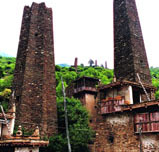 Danba County (Rongzhag) in the Garze Tibet Autonomous Prefecture in Sichuan Province is famous for its watchtowers.
Danba County (Rongzhag) in the Garze Tibet Autonomous Prefecture in Sichuan Province is famous for its watchtowers.
There are two bus routes from Chengdu, the capital city of Sichuan Province, to Danba County. One route is from Chengdu through Ya'an, Mount Erlang, Kangding (Dardo), the Tagong Grassland, the Bamei Stone Forest, and the Donggu Scenic Zone. The trip takes two days and one night, with an overnight stay in Kangding. The other route is a one-day trip from Chengdu through the Wolong Nature Reserve, Mount Siguniang, and Xiaojinchuan.
Once in Danba, people visit the watchtowers that are scattered about the county. With unique architectural features, the watchtowers in Danba are more outstanding than the ones in other areas of northwestern Sichuan Province, where the Tibetan and Qiang ethnic groups live in compact communities. The watchtowers in Danba vary in height from 16 to 35 meters. They stand in knots on hillsides or alone on the tops of undulating hills.
The people of Danba built watchtowers with stone materials. They used stone slabs for the walls and stone blocks for the foundations. The watchtowers were designed in polygonal shapes. The shapes include the square, pentagon, hexagon, and octagon. It is said that there was once a watchtower with 13 sides. Built by closely laying stone slabs together, the walls of these watchtowers are perfectly even and straight. According to archaeologists, the people of Danba began to build walls using stone slabs in 1700 BC.
Danba has preserved four kinds of watchtowers: Yao'ai (Strategic Pass), Fenghuo (Beacon-Fire), Zhai (Village), and Jia (Dwelling). The Yao'ai watchtower was built at passes and places of strategic importance. "If one man guards the pass, ten thousand can not get through"; and these watchtowers are testaments to this old Chinese saying. The Fenghuo watchtower was built on hilltops for the purpose of transmitting messages. To protect inhabitants and property, the Zhai watchtower was built at the entrance of villages. The Jia watchtower was built inside the village and was connected to the dwelling houses. It was used as storage in peacetime and as a defense during wartime.
All of the watchtowers in Danba have a door fitted about five meters above their foundation; and people must climb a wooden ladder to get into them. When the villages were invaded, people hid in the watchtowers. They drew back the ladder and closed the door so that the invaders could do nothing against them. The watchtowers also have apertures from which archers could shoot at invaders.
There are many stories concerning the construction of these watchtowers in Danba. One of the stories is about a ferocious evil spirit in the Dadu River Valley long ago. The evil spirit stole boys' souls. So when a boy was born, his family would build a watchtower to protect him from the spirit. Following the birth of a son, family members began to smelt and forge iron and would add one floor to the watchtower every year. By the time the boy was 18 years old, the watchtower had risen 18 floors and the iron had been forged into a sword. The parents presented their son with the sword to encourage him to bravely vanquish the evil spirit.
In addition to watchtowers, visitors can enjoy the Tibetan life-style and customs of the Danba people, including their distinctive costumes and ornaments and their songs and dances. The people of Danba are hospitable and will entertain you with their homegrown seasonal fruits and nuts when you enter their homes.
(China Pictorial December 18, 2002)
|

